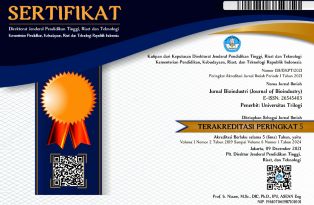RESPON TANAMAN CABAI RAWIT TERHADAP PEMBERIAN PUPUK ORGANIK CAIR REBUNG BAMBU
Abstract
Keywords
Full Text:
PDFReferences
Adil WH, Sunarlim N, Roostika I. 2005. Pengaruh Tiga Jenis Pupuk Nitrogen Terhadap Tanaman Sayuran. Jurnal Biodiversitas 7 (1) : 77-80
Badan Pusat Statistik, 2018. Statistik Tanaman Sayuran dan Buah-buahan Semusim. http://www.bps.go.id (diakses 15 Januari 2020).
Duaja MD, Gusniawati ZF, Gani, Salim. 2012. Pengaruh Jenis Pupuk Organik Cair Terhadap Pertumbuhan dan Hasil Dua Varietas Selada (Lactuca sativa). 1(3): 154-160.
Ikpeme CE, Henry P, Okiri OA. 2014. Comparative Evaluation of The Nutritional, Phytochemical and Microbiological Quality of Three Pepper Varieties. Journal Food Nutrition Science 2 (3): 74-80.
Marpaung IH, Harahap A, Batubara LR. 2018. Pengaruh Pemberian Pupuk Sp-36 dan Mol (Mikroorganisme Lokal) Rebung Bambu Terhadap Pertumbuhan dan Produksi Tanaman Tomat (Solanum Lycopersicum Mill.). Volume 14 No 1. Hal 126-132.
Maruli, Ernita, Gustom H. 2012. Pengaruh Pemberian NPK Grower dan Kompos Terhadap Pertumbuhan dan Produksi Tanaman Cabai Rawit (Capsicum Frutecent L). Dinamika Pertanian. 27 (3): 149-256.
Musfiroh I, Mutakin M, Angelina T, Muchtaridi. 2013. Capsaicin Level Of Various Capsicum Fruits. International Journal of Pharmacy and Pharmaceutical Sciences. 5 (1): 248-251.
Nugroho A. 2014. Meraup Untung Budidaya Rebung. Yogyakarta : Pustaka Baru Press.
Pramarta RG. 2014. Identifikasi Spesies potuvirus Penyebab Penyakit Mosaik pada Tanaman cabai Rawit (Capsicum Fruitescens L.) Melalui Sikuen Nukleotida Gen Coat Protein. Denpasar. Universitas Udayana.
Rahmawati N. 2005. Pemanfaatan Biofertilizer Pada Pertanian Organik. Tesis. USU e-Repository. Medan.
Salisbury FB and Ross CW. 1995. Fisiologi Tumbuhan jilid 3. Penerjemah Lukman, D.R. dan Sumaryono. Bandung: ITB
Setyamidjaja D. 1986. Pupuk dan Pemupukan. Cv. Simplex. Jakarta. 122 Halaman.
Siahaan CD, Sitawati, Heddy S. 2018. Uji Efektivitas Pupuk Hayati Pada Tanaman Cabai Rawit (Capsicum Frutescens L). J Produksi Tanaman. 6 (9): 2053-2061.
Simanungkalit RDM, Suriadikarta DA, Saraswati R, Setyorini D, Hartatik W. (2006). Pupuk Organik dan Pupuk Hayati. Bogor: Balai Besar Litbang Sumberdaya Lahan Pertanian.
Syaifudin A, Mulyani L, Ariesta M, 2010, Pupuk Kosarmas Sebagai Upaya Revitalisasi Lahan Kritis Guna Meningkatkan Kualitas dan Kuantitas Hasil Pertanian, Universitas Negeri Solo.
Taniwiryono D, Isroi. 2008. Pupuk Kimia, Pupuk Organik, dan Pupuk Hayati, Balai Penelitian Bioteknologi Perkebunan Indonesia (BPBPI).
Wiekandyne D. 2012. Pengaruh Pupuk Urea, Pupuk Organik Padat dan Cair Kotoran Ayam Terhadap Sifat Tana, Pertumbuhan dan Hasil Selada Keriting di Tanah Inseptisol. Jurnal Sains Mahasiswa Agroteknologi. 4(1): 236-246.
Yeni T, Mulyani HRA. 2012. Pengaruh Induksi Giberelin terhadap Pertumbuhan dan Produksi Tanaman Cabai Merah (Capsicum Annum L) sebagai Sumber Belajar Biologi. Bioedukasi Jurnal Pendidikan Biologi.
DOI: https://doi.org/10.31326/jbio.v3i1.840
DOI (PDF): https://doi.org/10.31326/jbio.v3i1.840.g437
Refbacks
- There are currently no refbacks.
Editorial Office:
Fakultas Bioindustri
Universitas Trilogi
Jl. TMP Kalibata No.1
Jakarta 12760
Copyright Notice:


2.png)






2.png)







